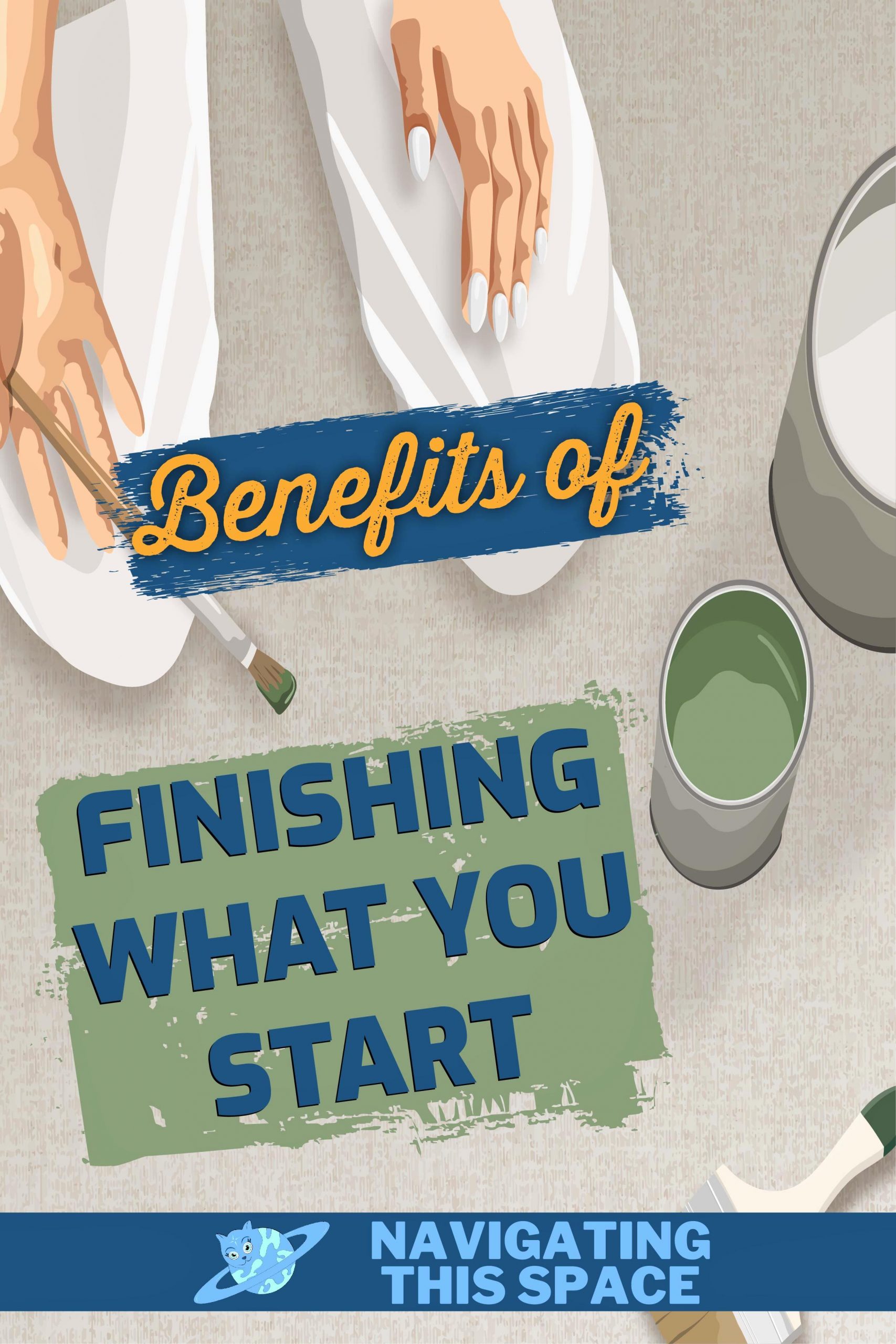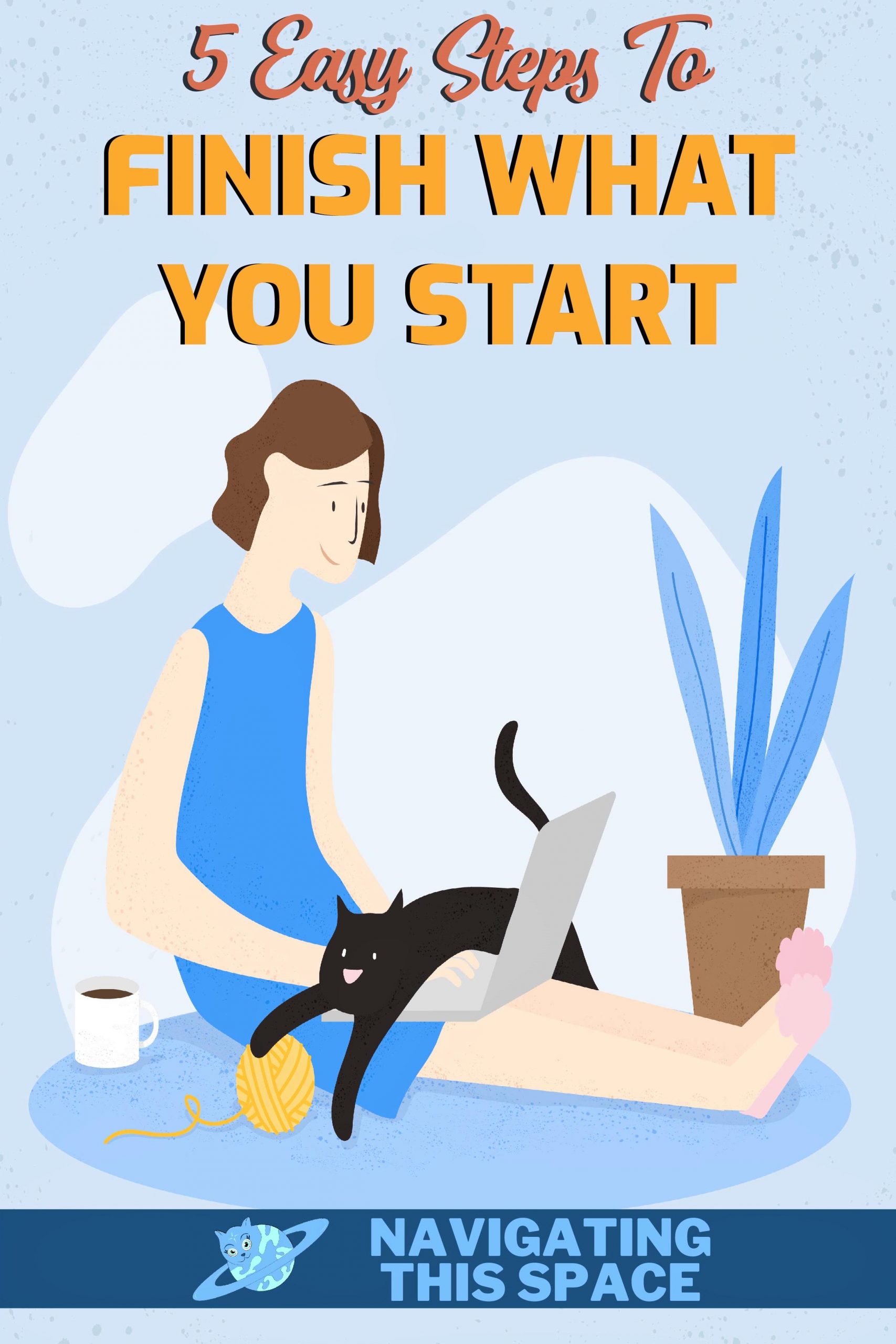Starting something is easy, but finishing it is where things become tricky.
We’ve all been there before. We get a brilliant idea for a project we just have to complete because it’s the best idea we’ve had. But fast forward two months, and that idea is still sitting on our laptop, in the garage, or the half-opened box unfinished. Sound familiar?
The issue is that we get so caught up in the starting phase that we never actually get around to finishing what we started. It’s a common issue that can be fixed with a little organization and planning.
Here are five steps to help you finish what you start. But first, let’s explore why you can’t seem to finish all of your great ideas.
- Why Can’t I Finish What I Start?
- The Science of Finishing What You Start
- The Benefits of Finishing What You Start
- Questions You May Have
This page contains affiliate links. This means that if you click a link and buy one of the products on this page, I may receive a commission (at no extra cost to you!)
Why Can’t I Finish What I Start?
Simple answer: life happens.
However, it’s a lot more complicated than that. The truth is, we often don’t finish what we start because we bite off more than we can chew or we’re not passionate about the project in the first place.
When it comes to projects, whether it’s a side hustle, painting a room in your house, or starting a small business, it may seem like such a simple task to complete. However, that thought quickly changes when you realize how much time and dedication you have to dedicate for it to turn out how you envisioned it.
This is called the planning fallacy, which is when we underestimate the time it will take to complete a task because we fail to account for the unexpected roadblocks that always seem to pop up.
According to Dr. Rosabeth Moss Kanter, a Harvard Business School professor and author of Confidence: How Winning Streaks and Losing Streaks Begin and End, “The middle is where the project gets hard, and you have to face reality.”
This is true for a lot of us because we estimate our new project will take a maximum of three months to finish, but in reality, it’s more like a year and a half.
After we started the project and are trying to solidify a schedule, we realize we don’t want to dedicate as much time as we originally thought. We don’t have the resources to finish it, or we simply just lose all interest in the idea.
This can be very discouraging especially if you’re passionate about the project, want to see it completed, and have already put in a lot of research. However, it’s important to remember that it’s not uncommon to finish something you’ve started, even if it takes much longer than originally planned.
So, what’s the solution? How can you make sure you finish what you started and don’t add another project to your ever-growing list of unfinished items?
Let’s get into the five steps to help you finish what you start.
The Science of Finishing What You Start

Step 1: Determine Why You Want To Finish What You Start
This may be a no-brainer, but it’s an important first step.
When you know your why, it will be easier to stay motivated when things get complicated, and it certainly will.
Your why should be something meaningful to you and aligned with your values.
For example, if your goal is to write a book, your why might be because you want to share your story and help others who are going through similar experiences.
Your why is your driving force, and the extra push you’ll need to finish your project.
Solidify your why and then move on to the next step.
Step 2: Identify Your Obstacles
What’s really holding you back from finishing?
Is it not having a to-do list, so you’re unsure where to start, a realistic idea, self-discipline, or is it because you fear the outcome, even though it may mean success?
Identifying your obstacles is key to developing a plan to work around them.
If you’re not sure what your obstacles are, ask yourself these questions:
– What has stopped me from finishing in the past?
– What usually gets in the way of my productivity?
– What do I do when I should be doing something else but feel overwhelmed?
Once you’ve answered these questions, you’ll have a better understanding of what’s holding you back, which makes it easier to develop strategies to work around them.
For example, if your goal is to renovate your living room area, but you don’t have a plan or budget, your obstacle is not having a clear idea of what you want or how much it will cost.
In this case, you’ll need to research and develop a plan before moving forward.
If you struggle with procrastination, your obstacle might be that the task doesn’t have a sense of urgency, or you’re not sure where to start.
In this case, you’ll need to create a timeline with specific deadlines and break the task into smaller, more manageable pieces.
Step 3: Make a Plan With a Deadline
Now that you know your why and what’s holding you back, it’s time to develop a plan.
Again, this may seem like common sense, but most people try to wing it and hope for the best. If you fall into that category, it’s time to get out of it.
If you want to increase your chances of success, it’s important to sit down and make a plan of action before you start. Even if it’s just a quick outline, having a plan will help you stay on track and focused.
This includes resource planning, how much resources you need (time, money, etc.), who can help you, and what steps need to be taken in order to reach your goal. Trying to do things without a plan is setting yourself up for failure.
Don’t forget to include a deadline!
Your new ideas don’t become a priority until they have a deadline attached to them. Adding a deadline will signal to your brain that it’s time to get started.
If you’re not sure how to get started, try using a project planner, a yearly planner, or a simple to-do list.
A planner should help you stay on track and achieve your goals, so keep that in mind when shopping for one.
I’d highly recommend getting my yearly planner, “What’s The Plan?”
It’s a printable planner that comes with everything you need to set and achieve your goals, including a goal achievement plan, to-do lists, monthly and yearly review sheets, and more to keep you on track.
You can learn more and purchase your copy here: What’s The Plan? – Yearly Planner
Step 4: Set Up a System That Works for You
Building a system that works for you will keep you on track to finishing your project.
This system should help you focus on your task, minimize distractions, and give you a way to track your progress.
There is no one-size-fits-all solution here. You’ll need to experiment until you find a system that works well for you and your project.
Some things to consider when setting up your system:
– How often do you need to work on your project?
– What time of day are you willing to dedicate to working on your project?
– What tools or resources do you need to work on your project?
– What’s the best way for you to track your progress?
Once you’ve answered these questions, you can start creating a system that works for you.
For example:
If you’re working on a website design project, your system might look something like this:
– Work on the project for one hour every day
– Use a project management tool for progress tracking
– Take breaks every 20 minutes and use a Pomodoro timer
– Set a goal of completing X tasks each day
– Repeat
Of course, you’ll need to keep in mind that your personal timeline will affect how often you work on your project and how long each session is.
Every day can look very different so if you have to break your dedicated hour into fifteen-minute increments, then do precisely what you need to get it done.
The most important thing is that you’re making progress each day and not letting yourself get overwhelmed by the project.
Once you begin to feel overwhelmed, you’ll start to withdraw from the project because it seems too daunting. You’ll find excuses not to work on it, and before you know it, you’ll lose all interest and motivation.
If you ever feel like you’re getting overwhelmed or that the project is too much for you, take a step back and reassess your system. Experiment with different techniques to make it more mental health friendly, and less toxic productivity driven.
Step 5: Take Actionable Steps Often
When it comes to finishing what you start, consistency is key.
This means taking small, baby steps every single day until your goal is reached.
For example:
If your goal is to write a book, a baby step might be writing for two to five minutes each day.
Yes, there will be days when life gets in the way and you can’t meet your daily quota but that’s ok!
The important thing is that you get back on track as soon as possible and don’t let one missed day turn into two … or three … or four …
If you find yourself consistently falling off the wagon, try setting weekly or monthly goals instead of daily ones.
Everything becomes less daunting when you’re not forcing yourself to be super productive every single day, so give yourself some room to breathe and live.
That way, even if you have an off week/month, you’re not as behind as you would be if you were working toward a daily goal.
Remember, progress not perfection!
Bonus Step 6: Celebrate Your Milestones Along the Way!
One of the main reasons people don’t finish what they start is that they get discouraged when they don’t see results immediately.
The journey toward any goal will have its ups and downs but it’s important not to get too caught up in the results and instead focus on enjoying the process.
To stay motivated throughout your journey (and prevent burnout), celebrate each milestone along the way — no matter how small!
For example,
I had a goal of completing Inktober, a drawing challenge to draw from a prompt every day in October that takes place every year.
I committed to drawing one illustration each day, and I started off great. However, by the fourth day, I had a big road trip, and by the eighteenth, another major project took most of my time, so I ended up not finishing all the prompts on their respective day.
But I celebrated the prompts I was able to complete because they were still a huge accomplishment!
The takeaway from this is that even if you don’t finish when you plan on accomplishing your goal, finishing the small milestones deserves to be celebrated.
This will help to keep you motivated and remind you of how far you’ve come — which is the most important part!
Give yourself permission to enjoy the process and soak up each accomplishment — big or small — along the way.
The Benefits of Finishing What You Start

Some personal benefits of finishing what you start are:
– Being more productive overall
– Feeling a sense of accomplishment and pride in yourself
– Reduction of stress levels
– You’ll be less likely to get overwhelmed
– Having more time to start your other passion projects
– Feeling confident, happier, and more motivated in general
So what are you waiting for? Get out there and start finishing those passion projects!
You owe it to yourself to see them through to the end.
What projects are you in the process of finishing? Let me know in the comments below.
Questions You May Have
How do I finish the work I started?
Break down your goal into small, manageable steps that you can complete daily or weekly. Set a deadline for yourself and stick with your schedule while taking necessary breaks to avoid burnout or overwhelm.
I can’t seem to finish anything I start! What’s wrong with me?
There’s nothing wrong with you! You just need to find a system that works for you. Try breaking down your goals into small, manageable steps or setting weekly/monthly goals and work toward them at your pace. If you overwhelm yourself, you won’t finish what you start.
How do you commit to finishing something?
Simply by making it a priority in your life. Schedule time for it in your day, week, or month and make sure to stick with your schedule. Break down your goals into small steps to easily see your progress. Most importantly, give yourself permission to enjoy the process!
Why do I keep starting new projects?
You lose interest in the other projects you’ve started and find it easier to start something new instead of figuring out what you need to get your past ideas off the ground. This is called the “shiny object syndrome,” and it’s a difficult habit to break. The best way to combat this is by not giving up on your first project because it got too hard or complicated.
Pin It!






Hi Jody, Helpful post I enjoyed reading. I find if I want to work on those projects and finish them, I need to start one project at a time.
It’s always best to work on one thing at a time Nancy, thanks for sharing!
This is a fantastic post! Thank you for sharing! Knowing how to finish what I start is extremely beneficial. I also found it helpful to practice self-discipline. Self-discipline is frequently viewed as a bad thing, something we must practice because it is the right thing to do. However, as I see it self-discipline is actually a form of self-love. Because when we love ourselves, we want what is best for ourselves, which includes taking care of our bodies, minds, and spirits. So, instead of thinking of self-discipline as a chore, I try to think of it as an act of self-love. This shift in perspective enabled me to achieve my goals more efficiently.
I agree Dinah, self-discipline is a form of self-love. Thank you for sharing your thoughts!
Enjoyed reading. I too have written about finishing what you start. You included great points.
Pastor Natalie (ExamineThisMoment)
Letstakeamoment.com
I’m happy that you always enjoy reading my articles, thank you for always coming back and also for commenting, I truly appreciate you.
It’s so easy to start something and not finish it. Thanks you so much for your helpful tips!
You are very welcome Tina, thank you for taking the time to read!
i have been doing this more and more and finish what I start before I add anything new
That’s the best thing you can do Jimmy, keep going!
This is such a good post! I have struggled with this so much over the years. Thank you for sharing!
I love this article! You have great advice about how to finish what you start. I love how you put emphasis on the fact that there’s nothing wrong with you, you just need to find a system. I look forward to reading more articles!